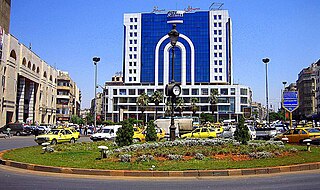
A mosque is a place of worship for Muslims. There are strict and detailed requirements in Sunni jurisprudence for a place of worship to be considered a mosque, with places that do not meet these requirements regarded as musallas. There are stringent restrictions on the uses of the area formally demarcated as the mosque, and in the Islamic Sharī‘ah, after an area is formally designated as a mosque, it remains so until the Last Day.

The Mosque of al-Hakim, nicknamed al-Anwar, is a major Islamic religious site in Cairo, Egypt. It is named after Al-Hakim bi-Amr Allah (985–1021), the sixth Fatimid caliph and 16th Ismaili Imam.

Faisal Mosque is a mosque in Islamabad, Pakistan. It is located on the foothills of Margalla Hills in Islamabad, the mosque features a contemporary design consisting of eight sides of concrete shell and is inspired by a Bedouin tent. The mosque is a major tourist attraction, and is referred as a contemporary and influential feature of Islamic architecture.
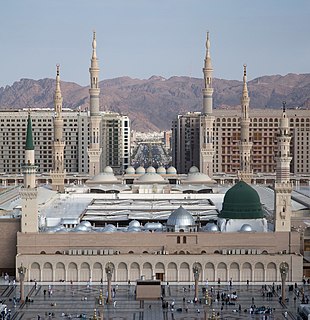
Al-Masjid an-Nabawī is a mosque established and originally built by the Islamic prophet Muhammad, situated in the city of Medina in the Hejaz region of Saudi Arabia. It was the third mosque built in the history of Islam, and is now one of the largest mosques in the world. It is the second-holiest site in Islam, after the Great Mosque in Mecca. It is always open, regardless of date or time.

Istiqlal Mosque in Jakarta, Indonesia is the largest mosque in Southeast Asia and the third largest Sunni mosque in term of capacity. This national mosque of Indonesia was built to commemorate Indonesian independence and named "Istiqlal", an Arabic word for "independence". The mosque was opened to the public 22 February 1978. Within Jakarta, the mosque is positioned next to Merdeka Square and the Jakarta Cathedral.
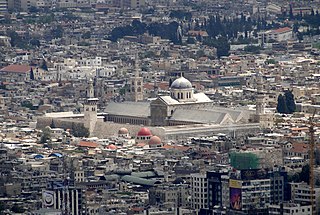
The Umayyad Mosque, also known as the Great Mosque of Damascus, located in the old city of Damascus, is one of the largest and oldest mosques in the world.
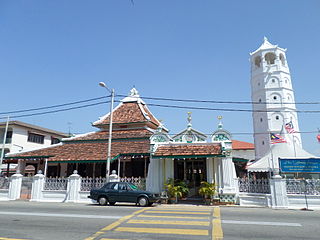
Tranquerah Mosque is a mosque in Melaka City, Melaka, Malaysia.

The Great Mosque of al-Nuri also called al-Nouri Mosque, is a mosque in Homs, Syria. It is situated off ash-Shouhada street, adjacent to the city's historical roofed souqs ("markets").
The Islamic Heritage Park is a famous attraction in Kuala Terengganu, Terengganu, Malaysia. This park is located at the island of Wan Man.

The Great Mosque of Aleppo or the Umayyad Mosque of Aleppo is the largest and one of the oldest mosques in the city of Aleppo, Syria. It is located in al-Jalloum district of the Ancient City of Aleppo, a World Heritage Site, near the entrance to Al-Madina Souq. The mosque is purportedly home to the remains of Zechariah, the father of John the Baptist, both of whom are revered in Islam and Christianity. It was built in the beginning of the 8th century CE. However, the current building dates back to the 11th through 14th centuries. The minaret was built in 1090, and was destroyed during fighting in the Syrian civil war in April 2013.
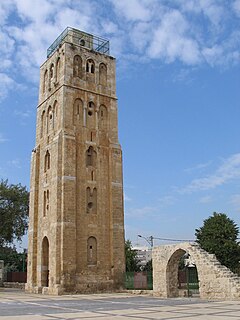
The White Mosque is an ancient Ummayad mosque in the city of Ramla, Israel. Only the minaret is still standing. According to local Islamic tradition, the northwest section of the mosque contained the shrine of a famous Islamic saint, Nabi Salih.

The Al-Omari Mosque is an early Islamic-era mosque in the Roman city of Bosra, Syria. It was founded by Caliph Umar, who led the Muslim conquest of Syria in 636 CE, and it was completed in the early 8th century by Caliph Yazid II. The mosque was renovated in the 12th and 13th century CE by the Ayyubid dynasties.

The Khalid ibn al-Walid Mosque is a mosque in Homs, Syria, located in a park along Hama Street in ash-Shuhada Square. Noted for its Ottoman-Turkish architectural style, the mosque is dedicated to Khalid ibn al-Walid, an Arab military commander who led the Muslim conquest of Syria in the 7th century following the decisive Battle of Yarmouk, which put an end to Byzantine rule in Syria. His dome-topped mausoleum is located in a corner of the prayer hall and has served as a pilgrimage center. Two tall minarets with narrow galleries constructed of alternating horizontal rows of white and black stone are situated at the building's northwestern and northeastern comers and reflect the traditional Islamic architecture style of the Levant.

The Great Mosque of Central Java is a mosque in the city of Semarang, Central Java, Indonesia.

The Great Mosque of Mecca is a mosque that surrounds the Kaaba in the city of Mecca, Saudi Arabia. It is a site of pilgrimage for the Hajj, which every Muslim must do at least once in their lives if able, the rites of which includes circumambulating the Kaaba within the mosque. It is also the main phase for the ‘Umrah, the lesser pilgrimage that can be undertaken any time of the year. The Great Mosque includes other important significant sites, including the Black Stone, the Zamzam Well, Maqam Ibrahim, and the hills Safa and Marwa. It is open, regardless of date or time.

Andalas Grand Mosque is a mosque located in Andaleh Street no.56, Andaleh, East Padang district, Padang, West Sumatra, Indonesia. The mosque consists of a green building with two floors which has area of 1,200 m2, and a minaret in the southeast and an entrance gate in the south.
Jami Mosque of Sintang also known as Sultan Nata Mosque is a mosque located in Sintang, West Kalimantan, Indonesia. The mosque is located within the complex of Istana al-Mukarrammah, the main palace of the Sultanate of Sintang, a kingdom in Sintang which existed since the 13th-century.

Al-Khulafa Mosque is a historic Sunni Islamic mosque located in Baghdad, Iraq. The mosque dates back to the Abbasid era and was commissioned by the 17th Abbasid Caliph Al-Muktafi during 902-908 in order to establish the Jama Masjid near his castle. Due to this historical circumstances, the mosque is often also called as Al-Qasr Mosque which literally means the mosque of the castle in Arabic. Later the mosque was dubbed as the Mosque of Caliph, and this had turned into the current name Al-Khulafa Mosque in the later generations. The mosque is one of the historic landmarks of the city of Baghdad. The mosque was mentioned in the Ibn Battuta’s travel record when he visited Baghdad in 1327.
